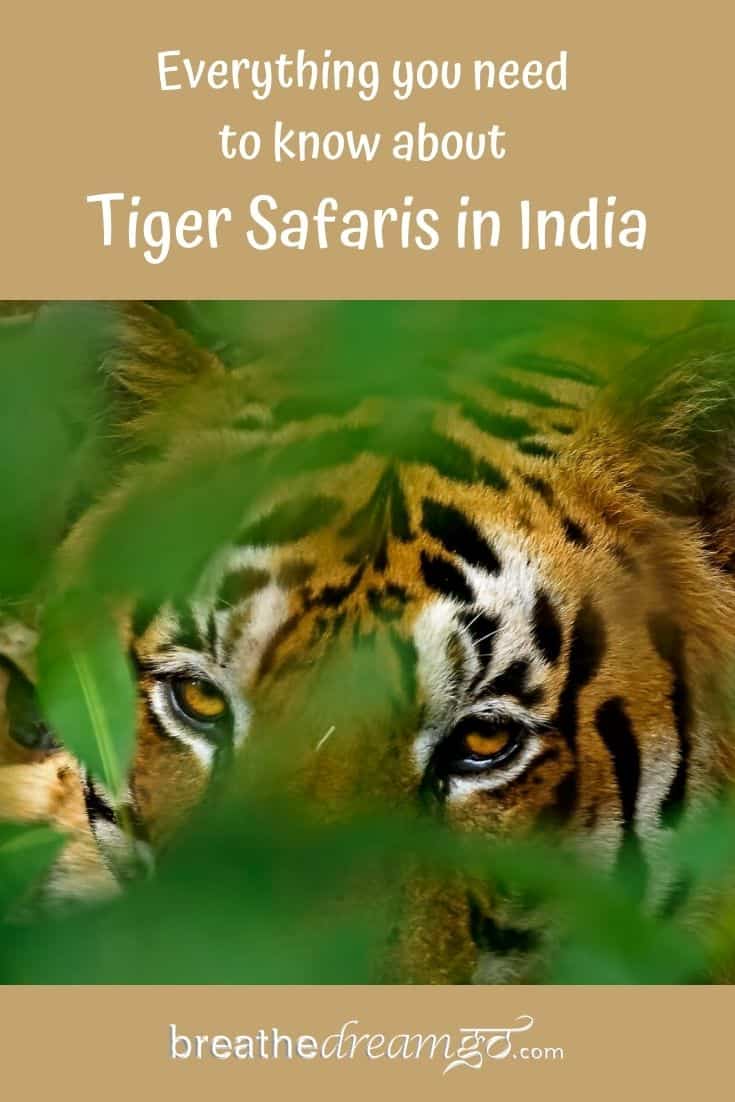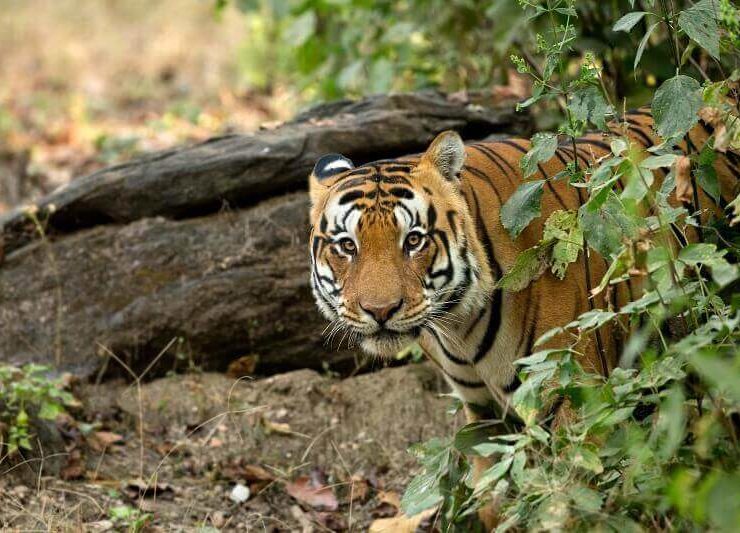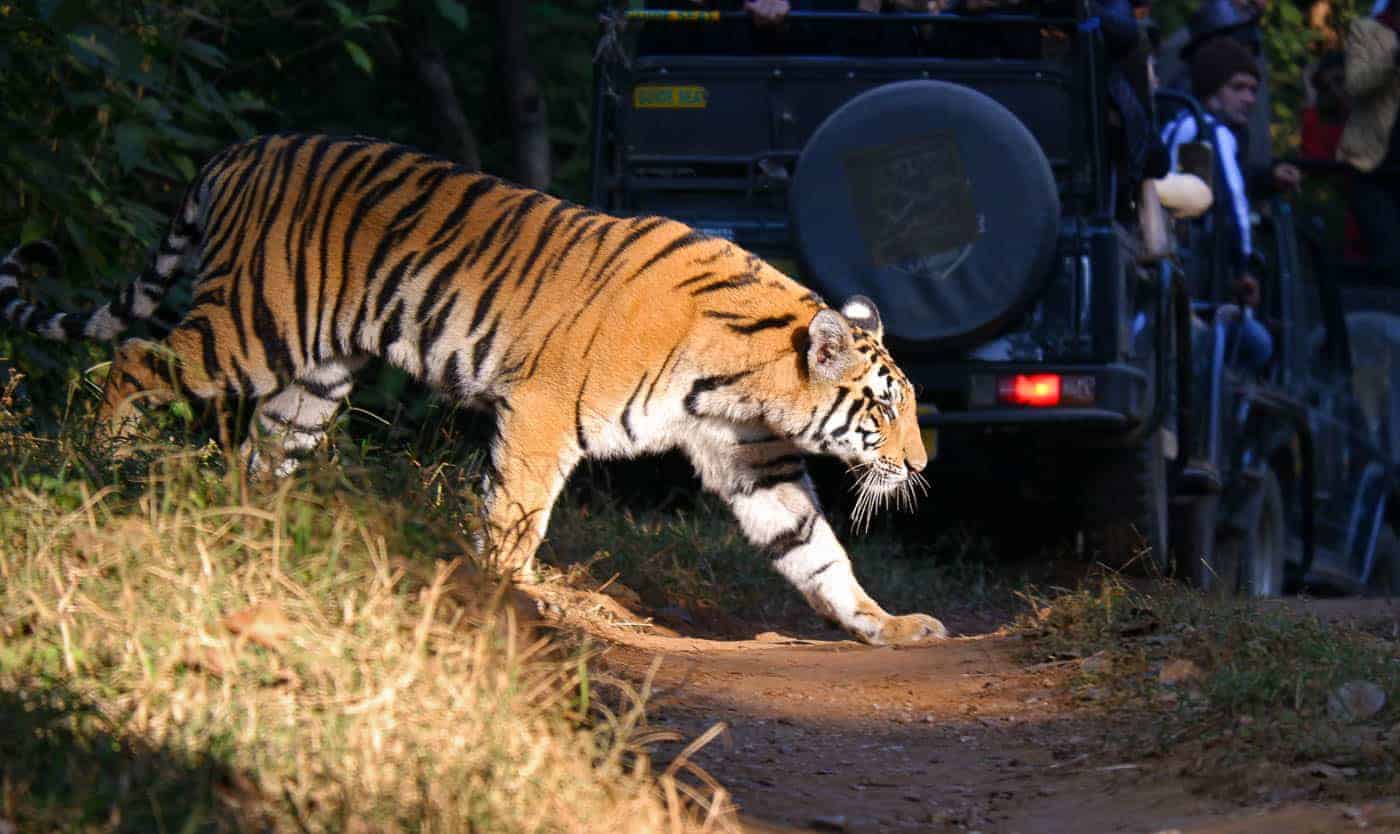
Table of Contents
Tiger safaris in India: Everything you need to know about tiger reserves and wildlife safaris
SEEING A TIGER while on tiger safari in India is a dream come true for many travellers and wildlife enthusiasts. India has about 70% of the world’s wild tigers, and is home to about 50 tiger reserves — and it’s the ideal place to plan a wildlife and tiger safari. In this post, I will tell you everything you need to know — from where to spot a tiger in India, to best times for a wildlife safari, to best wildlife lodges, and what to pack and what to wear.
Over the past three four five years, I’ve been on dozens of tiger safaris in India — and I have seen 23 26 29 31 tigers in the wild. Going on a wildlife and tiger safari in India is one of the most exciting travel adventures the country offers.
Explore India’s top tiger reserves with INDIA FOR BEGINNERS!
The India for Beginners Wildlife and Tiger Safari tour will take you to four of India’s top tiger reserves. Stay in luxury eco lodges and immerse in the Indian jungle on wildlife safaris. Come with us on the adventure of a lifetime.
To me, there is almost no greater adventure than waiting in an open jeep, in the pre-dawn gloom, for the tiger reserve gates to open, and then driving into the forest as the golden light of dawn illuminates the primeval scene for a jungle safari. The air is filled with the songs of a myriad brilliant birds as herds of graceful spotted deer graze in the rolling meadows. Meanwhile, lurking silently in the shadows …a flash of stripes, a roar, power and poetry in feline form … the magnificent Royal Bengal Tiger.
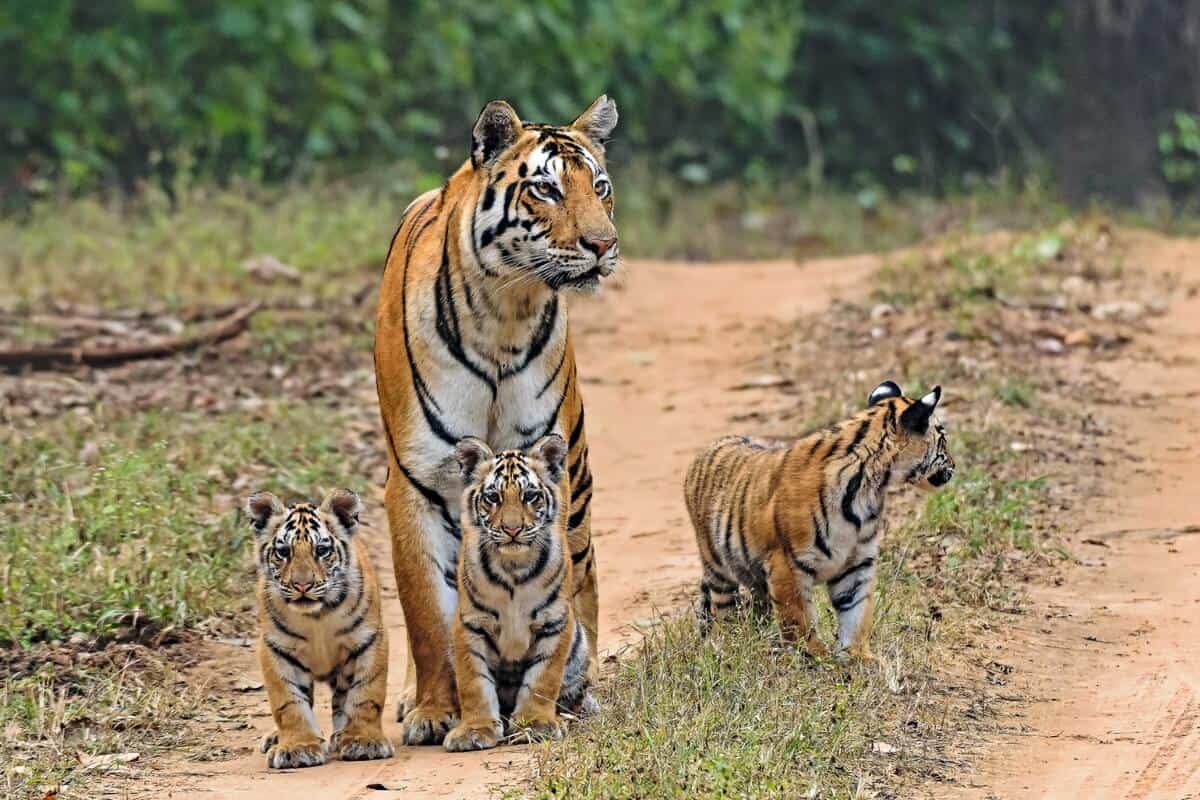
Tiger conservation in India
Thanks to tiger protection and conservation measures that started in the 1970s, India’s wild tiger population is on the rise. Every four years a tiger census is conducted. In 2008, there were 1,411 tigers in India, increasing to 1,706 in 2010, to 2,226 in 2014, and to 2,967 in 2018. Madhya Pradesh had the maximum number of tigers at 526, followed by Karnataka at 524, and 442 in Uttarakhand.
There are 50 tiger reserves scattered throughout the country dedicated to protecting and conserving them, ideal places for a jungle safari. Madhya Pradesh, a large state in the very centre of India, has six tiger reserves – the most of any state in India – including my favourite, Kanha (you can read my Guide to Kanha National Park here) and Bandhavgarh (you can read my Guide to Bandhavgarh National Park here). And Guide to Corbett National Park and Tiger Reserve. And here, you can read about the naturalist training course I took in Satpura Tiger Reserve and here for a comprehensive guide to the animals of India.
Did you know:
- tigers are the biggest cats
- the species found in India is the Bengal Tiger (Panthera tigris tigris)
- Bengal tigers (or Royal Bengal tigers) are the most numerous tiger species in the world and are also found in Bangladesh, Nepal, and Bhutan
- India has about 70% of the world’s wild tigers
- Madhya Pradesh has the highest number of tigers at 526, closely followed by Karnataka at 524 and Uttarakhand at 442 (2019 numbers).
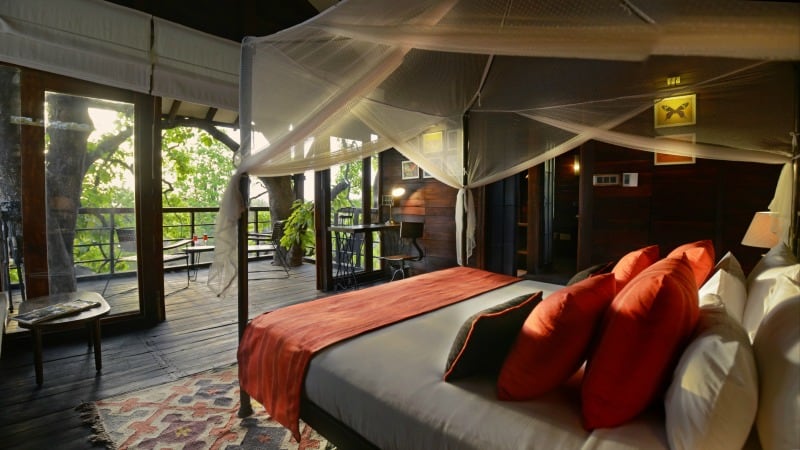
Best wildlife lodges in India
There are wildlife lodges, or jungle lodges and resorts, scattered outside the main gates of almost every tiger reserve in India. They range from basic and cheap, to mid-range and affordable, to luxury and beyond. Safe to say, there are wildlife lodges for every budget.
Usually, you can book your accommodation and tiger safaris at the same time, as a package — and this is highly advisable as there are more room nights than safari bookings in most parks. It is also recommended that you book at least three months (to six months) in advance. The limited number of vehicles and guests allowed into the tiger reserves of India ensure the animals are minimally disturbed. However, this means the parks can be fully booked up, and you will be locked out.

Wildlife in Asia
This post is part of a series on Breathedreamgo about Wildlife in Asia that seeks to highlight rare, unique, endangered, and/or fascinating animals in Asia. The series includes:
When you stay in a higher-end lodge, the services of a highly trained and English speaking naturalist will be included. This is worth its weight in gold! Having a good naturalist with you when you enter a tiger reserve for a jungle safari can make a complete difference in your enjoyment and satisfaction.
My number one choice is to travel with Pugdundee Safaris. Their lodges are truly beautiful, and away from the commercial zones, plus their naturalists are top-notch. They also serve excellent food, lots of fun activities, and unexpected surprises, and they follow sustainable practices, too — such as using natural materials in the construction of the lodges, banning plastic water bottles, and much more. Please read Pugdundee Safaris: Home base for tiger safaris in India.
I will be adding suggestions for recommended wildlife lodges below each park mentioned. Note that all properties listed are TOFTigers certified for sustainable practices in providing eco-friendly nature-based tourism accommodation and experiences.
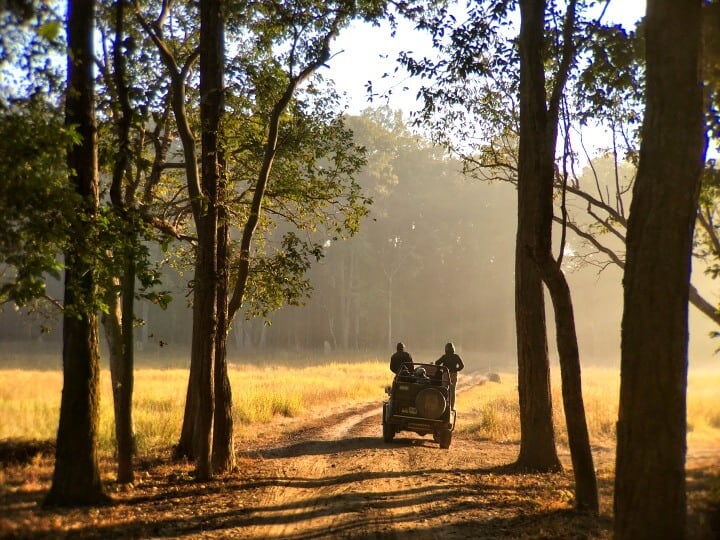
7 Best tiger reserves in India
These parks below are my favourites, and they are also the best places to see a wild tiger in India. Naturally, there are never any guarantees you will see a wild tiger when you go on a tiger safari in India – the parks don’t allow radio collars or walkie talkies. Part of the fun is the chase, and not knowing what will happen. The guides and naturalists use their skills and knowledge of the parks and the tiger population to track tigers on a jungle safari. But, honestly, it doesn’t matter. These parks are so beautiful, and so full of birds, animals, and scenic landscapes that you won’t care. In fact, I truly believe you increase your chances of seeing a tiger by staying relaxed, appreciating the moment, and NOT pressuring the guides and naturalists.
Kanha National Park and Tiger Reserve, Madhya Pradesh
This is a succinct description of Kanha National Park: The largest park with the biggest cats. The only problem with this description is that it leaves out the magic. Kanha is my favourite park in India, and one of my favourite places on earth.
Kanha tiger reserve is one of the most popular parks in India, and in peak season it books up completely. Booking your safari, tour, and/or lodge visit about three months in advance, or more, is highly recommended.
At 940 square kilometres in the core zone, and 1,009 square kilometres including the buffer zone, Kanha is the largest park in Central India. The park occupies a large forested area in the southern part of Madhya Pradesh, near Mandla. There are three gates, Katia/Kisli, Mukki, and Sarhi; four core zones, Kanha, Kisli, Mukki, and Sarhi; and three buffer zones, Khatia, Khapa, and Mukki. Kanha is my favourite zone, but all of them are beautiful and worthwhile.
There are many reasons as to why Kanha tiger reserve is such a sensational park. One is that parts of this park have been a wildlife sanctuary since 1933. In 1955, about 300 square kilometres was declared a national park. And in 1973, 940 square kilometres became one of India’s original nine Project Tiger Reserves. There is also an abundance of wildlife and it’s home to the rare and magnificent Barasingha hard-ground swamp deer. Plus it’s a beautiful and very well-managed park and has been home to many legendary tigers such as Munna, T-17, the erstwhile King of Kanha.
More information: Read my Guide to Kanha National Park here.
Park timings: The park is open for visitors from October 1 to June 30. It closes for the afternoon every Wednesday. Exact safari timings change throughout the season, so check with your lodging or provider.
When to go: You can go to Kanha anytime, from when it opens on October 1 to closing on June 30. There’s so much to see, and it’s such a beautiful park. The moist sal forest makes it chilly in December and January, but a bit cooler in the hot months. The professional wildlifers and photographers tend to go to Kanha between April and June for the best photo opportunities.
How many tigers? The most recent count was 105 (spring 2020).
Best wildlife lodges in Kanha:
- Book Kanha Earth Lodge on Agoda.com or Booking.com
- Book Kipling Camp on Booking.com or TripAdvisor.com
- Book Singinawa on Agoda.com or TripAdvisor.com
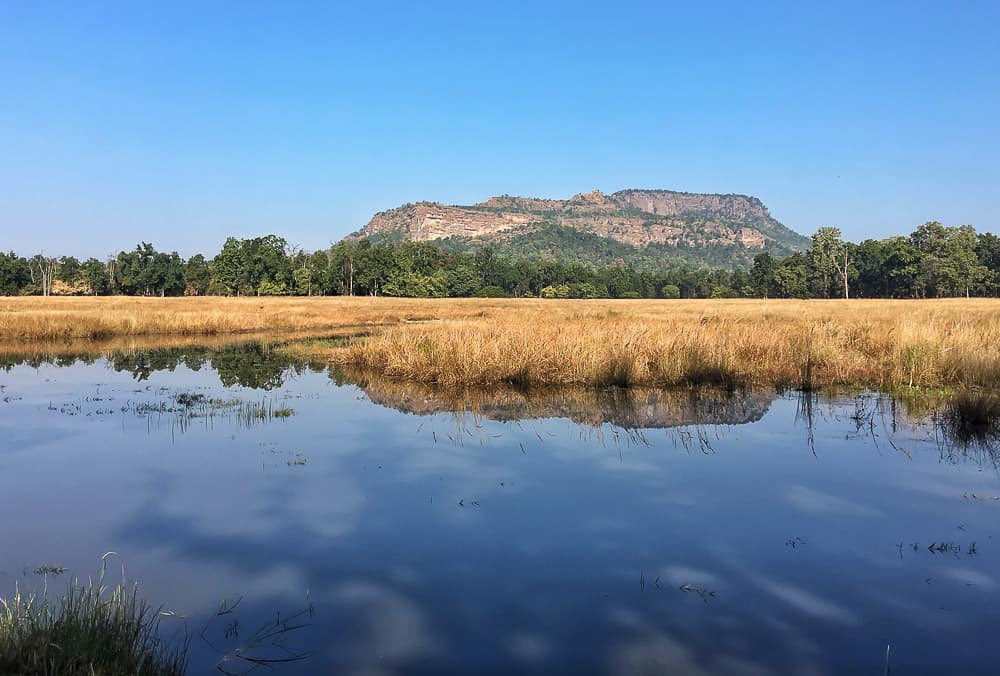
Bandhavgarh National Park and Tiger Reserve, Madhya Pradesh
What’s the best place to see a wild tiger in India? There’s some debate of course, but many will say Bandhavgarh National Park is the best place for tiger safari in India. In other words, Bandhavgarh gives you the best chances of spotting a tiger in India. Bandhavgarh National Park’s unique terrain, combined with the density of tigers, makes it a great place for a tiger and wildlife safari in India.
I saw my first wild tiger in India in Bandhavgarh, on my very first safari in the park! Can’t believe I managed to capture this video, below, I was so excited my hands were shaking.
READ my account of A Day in the Life of a Tiger Guide when I visited Bandhavgarh with Naresh “Gudda” Singh.
Bandhavgarh park is divided into a core area, with three zones open to the public, and a buffer zone, totalling 1,598 square kilometres (including Panpatha Wildlife Sanctuary). The core area is 716 square kilometres, with the buffer zone adding another 820 square kilometres – but the area open to the public is only 105 square kilometres.
The zones open to the public are Tala, Magadhi, and Khitauli, and they each restrict the number of vehicles that can enter. Each zone in Bandhavgarh has a unique flavour, and offers different benefits so it is worthwhile to visit all three.
More information: Read my Guide to Bandhavgarh National Park here.
Park timings: The park is open for visitors from October 1 to June 30. It closes for the afternoon every Wednesday. Exact safari timings change throughout the season, so check with your lodging or provider.
When to go: According to Madhya Pradesh Tourism, Bandhavgarh National Park has the highest density of Royal Bengal tigers in the world. Personally, I have seen one or more tigers EVERY time I have been in Bandhavgarh — and indeed saw my very first tiger there on a sunny afternoon in December 2017. For tiger sightings, you can go at any time of the year (except monsoon when the park is closed).
How many tigers? 80+ adult tigers (estimated in October 2020)
Best wildlife lodges in Bandhavgarh:
- Pugdundee Safaris King’s Lodge
- Pugdundee Safaris Tree House Hideaway
- Taj Safaris Mahua Kothi
- Samode Safari Lodge
Ranthambore Tiger Reserve, Rajasthan
Ranthambore is one of the most popular and well-known tiger reserves in India and it’s also one of the busiest — due to its location within driving distance of Delhi and Jaipur. A Ranthambore safari is a favourite activity in India. Ranthambore is located in the Sawai Madhopur district of southeastern Rajasthan, which is about 130 kilometres from Jaipur.
The park covers an area of 392 square kilometres in the vicinity of the Aravali range and the Vindhya plateau. There are now 10 safari zones in Ranthambore National Park (five have been added due to demand). Many people believe that Zones 1-5 (and especially 3) are the best for spotting tigers.
Ranthambore is an extremely photogenic park with rolling hills, shimmering lakes, and a diversity of landscapes from dramatic cliffs to lush greenery. It was once the former hunting grounds of the Maharajas of Jaipur, and several picturesque heritage sites such as the stunning cliff-top Ranthambore Fort, Jogi Mahal, an ancient temple, and ruins from the glory days of the Rajputs add to the park’s ambience.
Ranthambore is legendary for many reasons, not the least is the presence of Royal Bengal tigers of course. Here, the tigers are diurnal, which means they are active during the day — making it easier to spot one than in other parks. Over the years, Ranthambore has been home to some of the world’s most famous tigers, such as the incomparable Machli, who died in 2016. Machli’s well-regarded braveness and strength inspired wildlife documentaries, movies and TV shows.
Park timings: The park is open for visitors from October 1 to June 30. Exact safari timings change throughout the season, so check with your lodging or provider.
When to go: Ranthambore is probably the busiest tiger reserve in India, and one of the best places to see a tiger. You can go any time during the entire season, but like almost all the parks, the pre-monsoon season from April to June is the best time to go. Many people see their first tigers in Ranthambore, and sometimes at the most picturesque locations among lakes and ruins.
How many tigers? There are 75 tigers in the park (October 2020).
Best wildlife lodges in Ranthambhore:
- Oberoi Vanyavilas
- Khem Vilas
- Fateh’s Retreat
Corbett Tiger Reserve, Uttarakhand
Corbett is the granddaddy of tiger reserves in India. It was established in 1936 as a national park, and Project Tiger was launched in Corbett in 1973 to protect tigers in India. Corbett is named after legendary hunter-turned-conservationist Jim Corbett, who was born in nearby Nainital. Among other accomplishments, Corbett wrote a series of page-turning bestsellers such as Man Eaters of Kumaon (1944). You can read more about Jim Corbett and Kumaon here.
Corbett is located at the foot of the Himalayas in Kumaon, Uttarakhand, which makes it fairly easily accessible from Delhi. A Jim Corbett safari is a dream for many wildlife enthusiasts. The core area is 520 square kilometres, and is home to about 231 tigers. The subtropical climate of Corbett, plus its five major rivers, dense forests, ravines, ridges, grasslands, and plateaus shelter many endangered species, plus 50 mammal species, 549 bird species, 26 reptile species, and 488 different species of plants.
Corbett may not be the easiest place to see a tiger because of the size of the park and the dense flora, but it is a bird watcher’s paradise!
There are five tourism zones open for safari: Dhikala, Bijrani, Durga Devi, Jhirna, and Sonanadi. One of the unique features of Corbett is the presence of guest houses within the park, such as the Dhikala forest rest house.
Park timings: The park is open for visitors from November 15 to June 30. Exact safari timings change throughout the season, so check with your lodging or provider.
NOTE: Corbett opened on October 15, 2020.
When to go: November to February is the ideal time to visit Corbett as humidity is lower, the climate is temperate and animals are also effortlessly visible during this time as they come out to bask in the sun. Days are pleasantly warm, but the nights are quite cold, dropping down to 5 C. and cold winds can blow.
How many tigers? At the time of the last census, in 2018-19, Corbett had 231 tigers, the highest number of any park in India.
Best wildlife lodges in Corbett:
- Vanghat Lodge. Book on TripAdvisor.
- Jim’s Jungle Retreat. Book on TripAdvisor.
- The Ranger’s Lodge. Book on TripAdvisor.
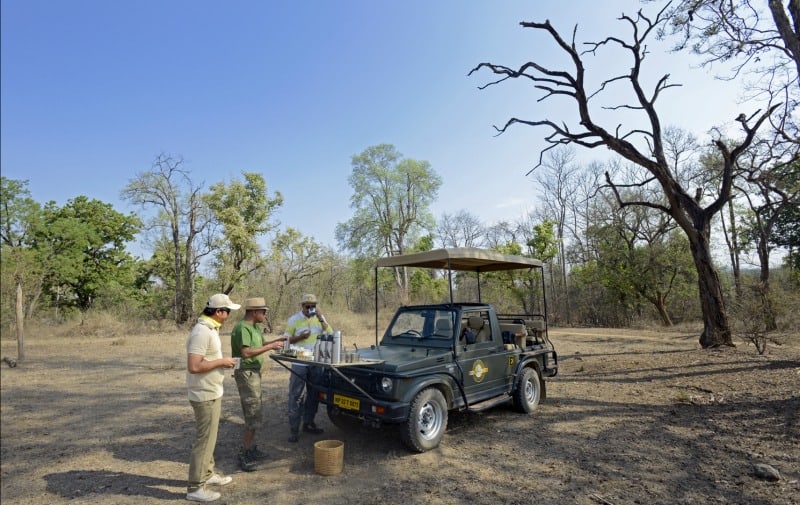
Pench National Park and Tiger Reserve, Madhya Pradesh
Pench is a beautiful national park that straddles the border of Madhya Pradesh and Maharashtra. It is known for scenic landscapes, an abundance of wildlife, and the place that inspired The Jungle Book.
The Jungle Book author Rudyard Kipling was born in Bombay in 1865 and grew up in India. Though he travelled widely as a journalist, he never visited the jungles of central India. Kipling asked fellow journalists for accounts of the region, and Seoni district — where Pench is located — provided inspiration for The Jungle Book.
The Jungle Book was published in 1894 and was an instant hit. It still continues to draw people to Pench — including me — who want to meet the famous characters from the book such as Akela (Indian wolf), Baloo (sloth bear), and Shere Khan (Royal Bengal tiger).
Pench has an area of 768 square kilometres (buffer) and 411 square kilometres (core). About 20% of the core is open for tourists, which is a typical percentage for national parks. The river Pench flows through the park, cutting it into two sections. Pench has been a wildlife sanctuary since 1965, and became a national park in 1975 and a tiger reserve in 1992. Pench has five gates in Madhya Pradesh, with most of the commercial activity at Turia gate. It also has gates on the Maharashtra side.
The park teems with an abundance of wildlife that includes Royal Bengal tigers, chital, jungle cat, wolf, Indian leopard, gaur, four-horned antelope, sloth bear, monkeys, jackals, wild dogs, striped hyena, barking deer and much more.
Pench became well-known as a tiger reserve because of several famous tigers — especially T-15 Collarwali, the Queen of Pench. She was born in 2005 and holds the record for most cubs born in the wild: 29, with 24 cubs surviving as per this account of famous tigers of Pench.
Park timings: The park is open for visitors from October 1 to June 30. It closes for the afternoon every Wednesday. Exact safari timings change throughout the season, so check with your lodging or provider.
When to go: November to February, the winter season, is the most pleasant time to visit Pench as the temperatures are cool and dry. Summer, March to June, is very hot and humid.
How many tigers? At last count, there were about 50 tigers in Pench.
Best wildlife lodges in Pench:
- Pugdundee Safaris Pench Tree Lodge
- Taj Safaris Baghvan
- The Riverwood Forest Retreat
Tadoba National Park, Maharashtra
Tadoba National Park is Maharashtra’s oldest and largest park and is one of India’s 50 protected tiger reserves. The total area is 1,727 square kilometres, and the terrain is hilly and dotted with lakes. In Tadoba tiger reserve you can find stands of teak trees, dense forest areas, sunny meadows, and deep valleys. The varied terrain helps protect wildlife and provides an ideal situation for tigers.
Tadoba tiger reserve is a good place for tiger spotting and is also known for sloth bears, wild dogs, and Central India’s best native woodland bird species. The two most popular entrance gates are Kolara Gate and Mohurli Gate, and you can find hotels, resorts, and lodges concentrated around these gates.
Park timings: The park is open for visitors from October 15 to June 30. It closes for the full day every Tuesday. Exact safari timings change throughout the season, so check with your lodging or provider. Tadoba charges an extra camera fee.
When to go: Tadoba is always warm as it is in a tropical zone. For tiger sightings, the best period is March to June, when it is very hot and the animals are driven out to the waterholes.
How many tigers? Most recent count (2019) revealed 115 tigers and 151 leopards.
Best wildlife lodges in Tadoba:
- Pugdundee Safaris Waghoba Eco Lodge
- Irai Safari Retreat
Nagarhole National Park, Karnataka
Nagarole in Karnataka was once a hunting reserve for the royals of the Wodeyar Dynasty, rulers of Mysore. The park comprises moist, tropical and mixed deciduous forest, and two rivers flow through and around it: Kabini and Bandipur. Nagarhole was established as a wildlife sanctuary in 1955 and was upgraded into a national park in 1988. The park was declared as the 37th tiger reserve in 1999.
Nagarhole is rich in birds, wildlife, and many forms of flora and fauna — especially herbivores. Visitors can quite easily spot wild dogs, hyena, gaur, wild bears, leopards, sambar, four-horned antelopes, spotted deer, barking deer, wild boars, and tigers.
Elephants are the stars here — Nagarhole has the largest Asiatic Elephant density in the entire world. Visitors can watch elephants happily roaming in their natural surroundings, among bamboo thickets and lush forests.
Park timings: The park is open for visitors from October 1 to June 30. Exact safari timings change throughout the season, so check with your lodging or provider. Nagarhole charges an extra camera fee.
When to go: October to May is the best season to visit Nagarhole National Park.
How many tigers? At the time of the last census, in 2018-19, Nagarhole had 127 tigers.
Best wildlife lodges in Nagarhole:
- Evolve Back Kuruba Safari Lodge
- Red Earth Kabini
Essential information for tiger safari in India
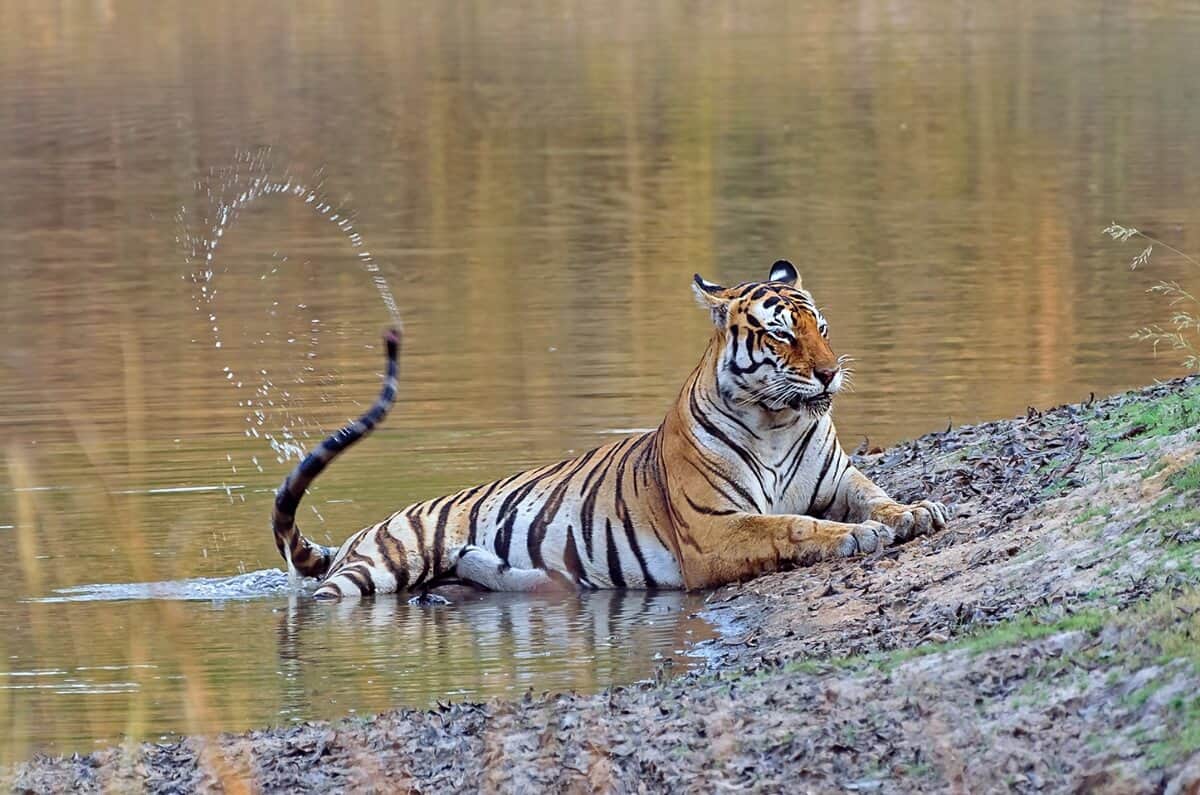
Best time of year for tiger safari in India
Most national parks and tigers reserves are closed during the monsoon (July, August and September) and open in early October or November. Generally, from October to May is the ideal time for tiger safari in India, however, this can change from park to park.
From November to February, morning safaris can be very chilly and you need warm clothes, a hat, and a scarf. Layers are ideal.
In many parks the best time to see a tiger is in the hot, dry months of March through June. At these times, the tigers are driven to waterholes and easy to spot. However, it is HOT and you need to be prepared for temperatures touching 40 C.
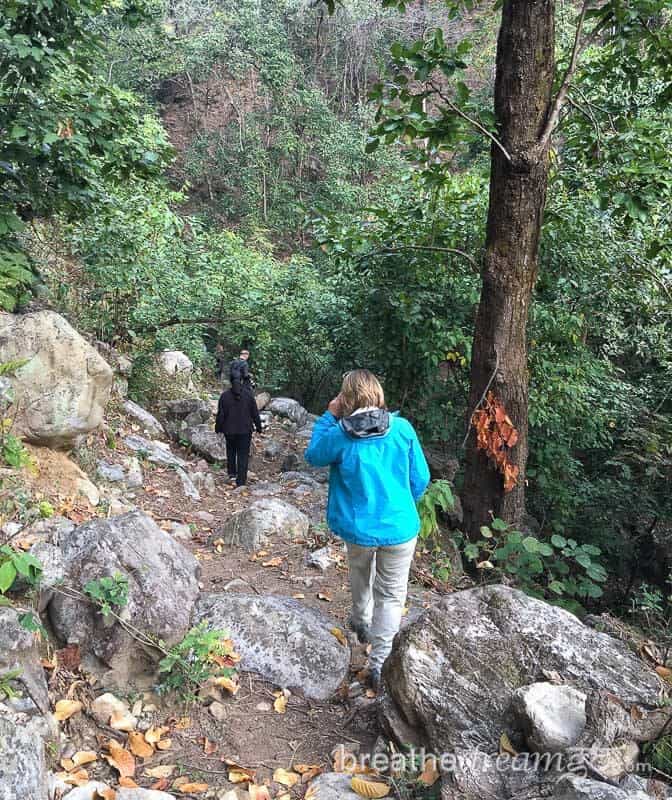
What to pack for a tiger safari in India?
Temperatures can vary from very chilly mornings to hot afternoons, so a range of clothes that will enable you to wear layers is highly advisable. Neutral, earth tones are required — no bright colours or white as they bother the animals. Read more about what to wear in the next section.
Binoculars are essential, they will really help you experience the jungle safari better. For the Indian forest, 8 x 42 or 10 x 50 is recommended. After much research, I bought Bushnell Binoculars (Bushnell H2O Waterproof/Fogproof Roof Prism Binocular, 8 x 42-mm).
If you bring a camera, a zoom lens is usually required for photographing animals and birds.
Other important items include:
- Reusable water bottle
- Thermos cup for carrying hot drinks on chilly mornings
- Buff or scarf to wear around your nose and mouth, to keep the dust out
- A sunhat that can be securely fastened and a warm cap
- Warm pajyamas
- A wool or fleece scarf for chilly mornings and evenings
- Small backpack or daypack
- Tissue packs, hand sanitizer, wet wipes, face masks
- Torch / flashlight or headlamp
- Sunscreen and mosquito repellant
- Comfortable, closed-toe shoes and socks
What should I wear for a tiger safari in India?
Never wear bright colours or white on wildlife safari. It disturbs the animals. Wear earthy tones like beige and khaki, and layers as it’s chilly in the morning and then warms up. A hat is essential and so is a buff, or scarf, to cover your nose and mouth on dusty drives.
I bring loose fitting outdoor trousers in khaki / beige that are big enough so I can wear a pair of thin, silk leggings underneath for really cold mornings. I also wear a long-sleeved, light-weight, merino wool sweater as a warm layer underneath, and a wind-breaking jacket made of Goretex as my top layer.
Wear sunscreen and bring sunglasses, plus binoculars, camera equipment, your passport, drinking water, and some 100 and 200 rupee notes to tip the guides.
I also recommend a water bottle, tissue, and hand sanitizer (plus wet wipes). Toilet conditions are not good in most of the parks, I’m sorry to say, you are basically on your own as far as hygiene is concerned (Kanha is a notable exception — a beautiful park, it also features excellent amenities).
What to wear checklist:
- Windbreaker jacket
- Fleece jacket
- Sunhat and warm cap
- Fleece scarf
- Buff, mask, or scarf to cover nose and mouth and protect from dust
- Under layers: t-shirts, merino wool undershirt, silk undershirt and leggings
- Long pants and long-sleeved shirts in beige, khaki, brown, green, grey, and other neutral tones
- Socks and closed-toe shoes
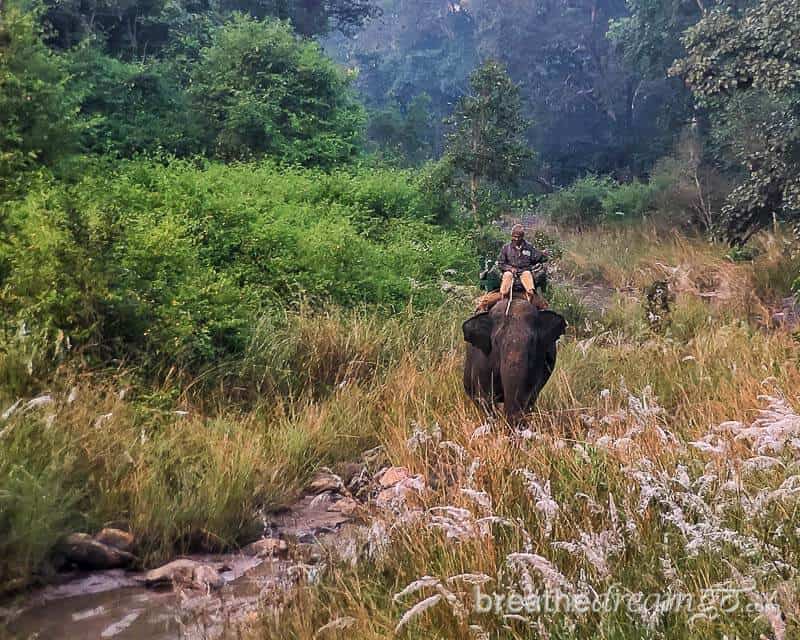
Tiger safari in India on elephants
Many people have a romantic vision of riding through the jungle on the back of a lumbering elephant. However, the truth is, this is actually an act of animal cruelty. Elephants cannot bear the weight of heavy loads on their spines, according to experts. Plus, many elephants used for tourism are not well cared for.
Nowadays, many tour operators are completely banning elephant riding on their tours. You can read more about why elephant riding is cruel, and how you can protect elephants, in my post Protecting Indian Elephants.
Thanks to Harpreet Singh, naturalist and manager at Kanha Earth Lodge, for the stunning photos of tigers. Check out his Instagram account here.
If you enjoyed this post, you can….
Sign up to The Travel Newsletter in the sidebar and follow Breathedreamgo on all social media platforms including Instagram, TripAdvisor, Facebook, Pinterest, and Twitter. Thank you!



